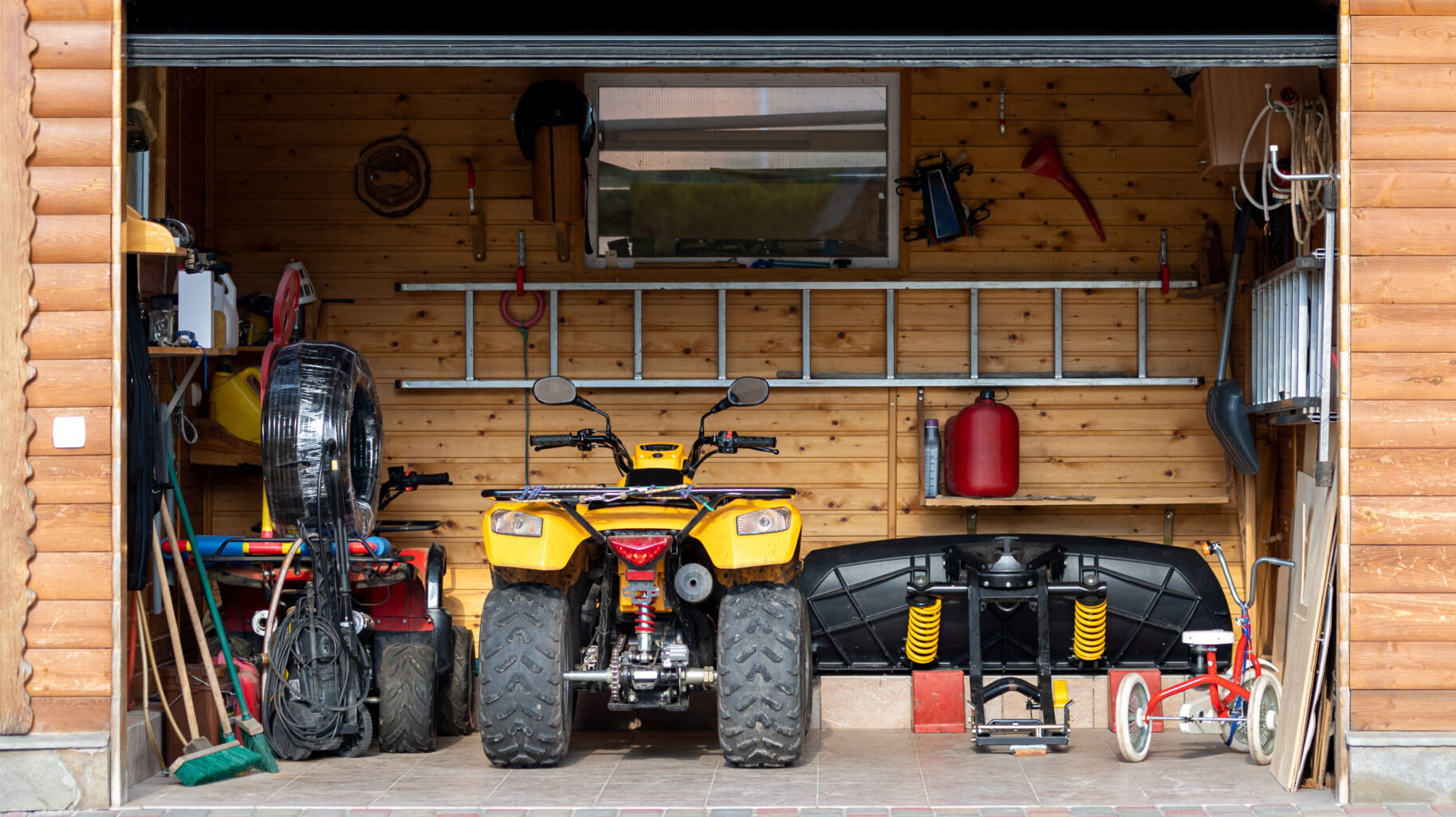Article takeaways
- Many ATV owners overlook small maintenance steps that could save them hundreds in repair costs after storage.
- How you store your ATV can impact everything from battery life to resale value, especially in changing weather conditions.
- Simple habits like monthly inspections and choosing the right cover can prevent long-term damage and get you back on the trail faster.
When you invest in an all-terrain vehicle (ATV), you’re not just purchasing a recreational vehicle—you’re investing in adventure, freedom, and the ability to explore off-road terrain with confidence. But just like any high-performance machine, your ATV requires regular maintenance, especially when it comes time to store it for the off-season. That’s where an ATV maintenance checklist becomes essential. Proper storage isn’t just about putting a cover over it and walking away; it’s about ensuring your vehicle stays in peak condition and is ready to ride the moment you are.
Improper storage can lead to costly mechanical issues like fluid breakdown, battery corrosion, tire damage, and mold. If left unchecked, these problems can reduce your ATV’s lifespan, lower its resale value, and create safety hazards. That’s why we created this comprehensive ATV maintenance checklist—to walk you through how to prep, protect, and periodically maintain your vehicle while it’s in storage.
Whether you’re using small vehicle storage, garage space, or a professional recreational vehicle storage facility, this guide covers every essential step: from pre-storage cleaning to fluid care, battery tips, monthly maintenance, and a post-storage inspection.
Why ATV Storage Maintenance Matters
While the importance of ATV maintenance in storage might feel like common sense, the real value lies in what it saves you—money, time, and long-term wear. A thorough ATV maintenance checklist helps prevent costly repairs by tackling small issues before they escalate. It ensures fluids stay fresh, corrosion is kept at bay, and tires or batteries don’t degrade in silence.
Here’s what a smart ATV maintenance strategy helps you achieve:
- Save money by avoiding preventable damage and expensive repairs
- Extend the lifespan of your ATV by reducing mechanical stress
- Ensure immediate usability by keeping critical systems functional during downtime
- Protect against environmental damage such as moisture, rust, and pests
- Preserve resale value through consistent upkeep and documentation
With regular attention, your ATV is more than just stored—it’s protected, preserved, and ready to ride. Whether you use recreational vehicle storage or small vehicle storage at home, maintenance means fewer headaches later and greater freedom when it’s time to hit the trail.
Pro Tip: Keep a dedicated maintenance log for your ATV. Documenting service dates, fluid changes, battery checks, and inspections not only keeps you organized—it also increases buyer confidence if you ever decide to sell your vehicle.
Pre-ATV Storage Checklist: A Clean Start for Long-Term Protection
Before you roll your ATV into storage, it’s crucial to give it a thorough clean, inside and out. Dirt, salt, and debris left on the surface can cause corrosion, while trapped moisture can damage internal systems and attract pests.
Start with an exterior wash using a pH-balanced, non-abrasive vehicle shampoo. Pay special attention to high-risk areas like the undercarriage, engine compartment, wheel wells, and drive chain—these spots accumulate the most grime. Once clean, dry the ATV completely, using microfiber cloths and a compressed air canister to remove moisture from hard-to-reach crevices. Moisture left behind can quickly turn into rust.
Interior cleaning matters, too. Clear out the air filter, vacuum or brush off any loose debris, and wipe down vinyl and plastic surfaces. If your ATV has cargo compartments or seating storage, double-check for any food wrappers or organic material that could attract rodents.
Here’s a quick reference chart to help you pick the right products for the job:
| Cleaner Type | Ideal Use | Best Practices |
|---|---|---|
| pH-balanced vehicle shampoo | Exterior surfaces | Use with soft sponge or mitt; rinse well |
| Compressed air canister | Undercarriage, engine compartment | Avoid direct spray on wiring connections |
| Microfiber towels | Drying and general wipe-downs | Pat dry to avoid swirl marks |
| Silicone-safe degreaser | Chains, axles, engine casing | Apply with brush and rinse thoroughly |
| All-purpose interior spray | Seats, storage compartments | Use sparingly and dry completely |
By following these ATV cleaning guidelines before storage, you reduce the risk of long-term deterioration and set the foundation for a smooth post-storage ride. The pre-storage cleaning step is the most important step to any well-rounded ATV maintenance checklist.
Pro Tip: If you’re also winterizing a trailer, RV, or toy hauler alongside your ATV, check out this guide to winterizing your RV for tips that can help protect your entire setup.
ATV Storage Maintenance Essentials for Long-Term Protection
Once your ATV is cleaned and prepped, don’t assume the job is done—this is where the long-term protection begins. Pay close attention to the key areas that tend to suffer most while your vehicle sits still: fluids, batteries, moving parts, and the overall storage environment. A few smart precautions now can save you time, money, and frustration when it’s time to ride again.
Fluid Maintenance Guide: Keep Systems Stable in Storage
Letting fluids sit unused for months can lead to gumming, corrosion, and bigger performance issues down the line. Before you store your ATV, it’s important to check and refresh the fluids that keep your engine and systems running smoothly:
| Fluid Type | Pre-Storage Action | Notes |
|---|---|---|
| Engine Oil | Change oil and replace filter | Prevents acidic buildup |
| Fuel | Add stabilizer and fill tank completely | Avoids condensation and degradation |
| Coolant | Check levels, replace if overdue | Protects engine from freezing/corrosion |
| Brake Fluid | Top off and inspect for clarity | Ensure responsive braking after storage |
| Differential Oil | Check and replace per manufacturer’s schedule | Often overlooked, but critical |
Pro Tip: Fuel stabilizer is especially important for preventing varnish buildup. Run the engine briefly after adding stabilizer to circulate it through the system.
Battery Care and Electrical System: Avoid the Silent Killer
A neglected battery can lose charge, develop corrosion, or even leak acid over time—especially in fluctuating temperatures. To protect your ATV’s electrical system during storage, you have a couple of solid options depending on your setup.
- Remove the battery and store it in a cool, dry, well-ventilated location away from direct sunlight or extreme temperatures. Before storing, clean the terminals with a wire brush and apply a thin layer of dielectric grease to prevent corrosion.
- If you have access to a power source, connect the battery to a trickle charger or smart maintainer that automatically cycles on and off to preserve battery health without overcharging.
Before you tuck everything away, test all electrical connections and inspect the wiring harness for any signs of wear, fraying, or rodent activity. Cover exposed terminals and moisture-sensitive components with silicone boots or plastic caps to reduce the risk of rust and corrosion building up during the off-season.
Mechanical Must-Dos Before Storing Your ATV
It’s not just fluids and batteries that need attention. Your ATV’s tires, brakes, and moving parts are equally important—and often overlooked.
- Inflate tires to the manufacturer’s recommended PSI to prevent flat spots, especially if your ATV will be sitting for more than a few weeks. Most ATVs fall between 4–8 PSI for sport and utility models, while UTVs and side-by-sides may require 12–25 PSI depending on tire size and load rating. Consider checking tire pressure monthly if the vehicle will remain in long-term storage.
Pro Tip: Don’t overinflate your tires for storage—it can actually stress the sidewalls over time. Stick to the manufacturer’s recommended PSI and check pressure monthly if stored long term. Using a stand to take the weight off is the best way to prevent flat spots.
- Raise the ATV off the ground using a sturdy stand, center jack, or ATV lift if available. This not only relieves pressure on the tires but also prevents suspension sag, protects wheel alignment, and keeps rubber from deforming under weight. For DIY ATV storage setups, even wood blocks under the frame can provide support and elevate the tires just enough to make a difference.
-
Lubricate all moving parts to keep them from seizing or wearing down while the vehicle sits. Here’s a checklist of key areas to address:
- Drive chain and sprockets
- Suspension pivots and bushings
- Throttle cable
- Brake cable and lever pivots
- Control arms and joints
- Foot peg mounts and shifter linkages
Pro Tip: Choose a lubricant appropriate for your ATV model and riding environment—silicone-based or all-weather formulas typically offer the best protection. Be sure to wipe off excess lubricant to avoid dust buildup, and cycle the controls a few times to ensure even distribution.
A well-lubricated, elevated ATV is less likely to suffer from mechanical stress, misalignment, or dry rot—keeping it safer and smoother to ride when you’re ready to hit the trail again.
- Inspect and test the brakes, including pads, rotors, and cable tension. Make sure pads aren’t too worn down and that the rotors are free of pitting or scoring. Lightly lubricate pivot points, and if you notice any pulling, sticking, or sponginess, have the system professionally inspected before storage. Consider applying an anti-corrosion spray to exposed brake hardware—just be cautious not to get any on the braking surface. If anything feels stiff or worn, address it before putting the ATV into storage to avoid deterioration that worsens while it sits.
- The chain/drive system takes the brunt of your ATV’s power transfer, so it deserves special attention before long-term storage. A neglected chain or belt can lead to jerky acceleration, misalignment, or even drivetrain failure. Follow this checklist to keep your chain/drive system fully maintained and functioning:
- Clean your chain thoroughly with a degreaser to remove dirt and old lubricant.
- Apply a chain lube designed for off-road use, rotating the wheels to ensure full coverage.
- Inspect the sprockets carefully—if you notice pointed or chipped teeth, it’s time for a replacement.
- For belt-driven systems, check for correct tension and look closely for signs of cracking, fraying, or hardening.
Pro Tip: Each ATV model may have different specs for drive tension, so consult your owner’s manual for adjustment guidelines. Keeping the chain or belt clean and conditioned reduces wear and protects handling performance during your first post-storage ride.
Create a Safe Storage Environment for Your ATV
Where and how you store your ATV plays a big role in how well it performs when it comes back out. Even if you’ve done all the prep work, poor storage conditions can quietly undo your efforts. To protect your vehicle, focus on temperature, humidity, ventilation, and pest control—plus the right type of cover.
Ideal conditions:
- Keep storage temperatures between 50–70°F
- Maintain humidity levels below 60% to avoid condensation and mold
- Ensure the space is well-ventilated to prevent stale air and mildew buildup
Storage protection checklist:
- Use a breathable ATV cover to reduce dust and moisture buildup without trapping condensation
- Avoid plastic tarps, which can seal in moisture and cause rust
- Place pest deterrents near entry points (peppermint oil, traps, or natural repellents work well)
- Add moisture absorbers or desiccant packs to small vehicle storage units or enclosed garages
If you’re storing your ATV for more than a few months, these environmental controls become even more important. Recreational vehicle storage facilities often offer climate-controlled options, which can reduce long-term wear on seals, gaskets, and electronics.
Pro Tip: If you also own a motorcycle or are storing other powersport vehicles, check out this guide to storing a motorcycle in self storage for more vehicle-specific tips.
Monthly ATV Maintenance During Storage: Stay Ahead of Surprises
Out of sight shouldn’t mean out of mind—especially when it comes to preventing long-term damage. Even if your ATV is stored in a safe, climate-controlled space, taking a few minutes each month to run a quick check can keep small problems from becoming expensive repairs later.
- Inspect the battery, especially if it’s on a trickle charger, to ensure it’s holding a charge and terminals remain clean
- Start the engine briefly every 3–4 weeks to keep fluids moving and internal parts lubricated (make sure the area is well-ventilated)
- Check for leaks, tire deflation, rust, or corrosion, especially around seals and connection points
- Look for pest activity such as droppings, chewed wiring, or nesting material
- Adjust your maintenance routine as weather shifts to accommodate for humidity, freezing temps, or heat
These small efforts can significantly extend the life of your ATV and prevent headaches when it’s time to ride again.
Pre-Riding Checklist: Ready, Set, Ride
When the time comes to bring your ATV out of storage, it’s worth taking a few extra minutes to go through a full safety and performance check. After sitting idle for weeks or months, key systems need a reset before hitting the trail.
- Reconnect and test the battery to ensure it’s holding a full charge and terminals are free of corrosion
- Inspect all fluid levels—including engine oil, coolant, brake fluid, and fuel—and top off or replace as needed
- Adjust tire pressure back to the manufacturer’s recommended PSI and inspect for any flat spots or cracking
- Check for signs of pest damage, such as nests or chewed wiring, and inspect seals for any signs of moisture intrusion or rust
- Test the brakes and throttle to ensure smooth operation, responsive controls, and no sticking or grinding
- Start the engine and let it idle for several minutes, listening for irregular noises and watching for fluid leaks as systems re-engage
A thoughtful reactivation process helps ensure your ATV performs safely and reliably—so you can get back to riding with confidence.
Keep Your ATV Trail-Ready with Smart Storage Maintenance
Taking the time to follow this ATV maintenance checklist now means less stress, fewer repairs, and a lot more fun when you’re ready to ride again. From fluid checks and battery care to storage conditions and reactivation tips, these simple steps keep your investment protected and trail-ready year-round.
Consider creating a personalized maintenance schedule or printing out your own checklist to stay on track. Small habits, like monthly battery checks or springtime fluid flushes, can go a long way toward extending your ATV’s lifespan.
Know someone who stores their ATV seasonally? Share this guide with fellow riders and help them avoid costly surprises, too.
If you’re still looking for the right place to store your vehicle, check out our tips on climate-controlled vs. non-climate-controlled storage and learn how to store your ATV safely.
Ready to find a secure, affordable storage unit near you? Visit Storage.com to compare ATV-friendly options and book the best solution for your needs.
A little planning makes all the difference—your ATV will thank you for it.
Want to keep this checklist handy? Download our printable ATV storage maintenance checklist to reference before, during, and after the season.





![Relocating RVs: An Expert Guide to Finding RV Relocation Deals and Cheap Motorhomes for Rent [2025]](https://blog.storage.com/wp-content/uploads/2025/03/rv-relo.jpg)
